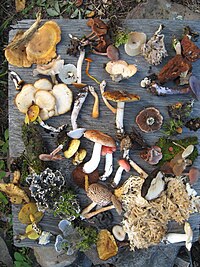
Photo from wikipedia
Abstract Large-scale high-resolution satellite observations of plant functional diversity patterns will greatly benefit our ability to study ecosystem functioning. Here, we demonstrate a potentially scalable approach that uses aggregate plant… Click to show full abstract
Abstract Large-scale high-resolution satellite observations of plant functional diversity patterns will greatly benefit our ability to study ecosystem functioning. Here, we demonstrate a potentially scalable approach that uses aggregate plant traits estimated from radiative transfer model (RTM) inversion of Sentinel-2 satellite images to calculate community patterns of plant functional diversity. Trait retrieval relied on simulations and Look-up Tables (LUTs) generated by a RTM rather than heavily depending on a priori field data and data-driven statistical learning. This independence from in-situ training data benefits its scalability as relevant field data remains scarce and difficult to acquire. We ran a total of three different inversion algorithms that are representative of commonly applied approaches and we used two different metrics to calculate functional diversity. In tandem with Sentinel-2 image-based estimation of plant traits, we measured Leaf Area Index (LAI), leaf Chlorophyll content (CAB), and Leaf Mass per Area (LMA) in-situ in a (semi-)natural heterogeneous landscape (Montesinho region) located in northern Portugal. Sampling plots were scaled and georeferenced to match the satellite observed pixels and thereby allowed for a direct one-to-one posterior ground truth validation of individual traits and functional diversity. Across approaches, we observe a reasonable correspondence between the satellite-based retrievals and the in-situ observations in terms of the relative distribution of individual trait means and plant functional diversity across locations despite the heterogeneity of the landscape and canopies. The functional diversity estimates, based on a combination of canopy and leaf traits, were robust against estimation biases in trait means. Particularly, the convex hull volume estimate of functional diversity showed strong concordance with in-situ observations across all three inversion methods (Spearman's ρ: 0.67–0.80). The remotely sensed estimates of functional diversity also related to in-situ taxonomic diversity (Spearman's ρ: 0.55–0.63). Our work highlights the potential and challenges of RTM-based functional diversity metrics to study spatial community-level ecological patterns using currently operational and publicly available Sentinel-2 imagery. While further validation and assessment across different ecosystems and larger datasets are needed, the study contributes towards a further maturation of scalable, spatially, and temporally explicit methods for functional diversity assessments from space.
Journal Title: Remote Sensing of Environment
Year Published: 2021
Link to full text (if available)
Share on Social Media: Sign Up to like & get
recommendations!